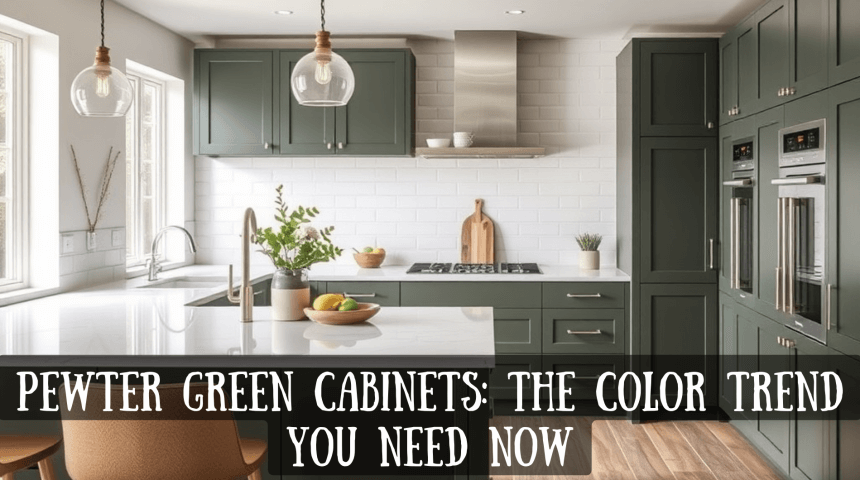Green makes kitchens feel alive, yet many choose white or beige as their cabinet colors.
You’ve browsed hundreds of kitchen photos online but can’t find a fresh color without being too bold.
The standard options leave your space feeling flat and uninspired. Does this sound familiar?
Here’s something that might surprise you: Pewter green cabinets blend the comfort of neutral tones with just the right pop of nature-inspired color.
This gentle, sophisticated hue adds character to your kitchen without overwhelming the space.
Let me show you why this shade deserves a spot in your home and how it can transform your cooking space into something special.
Pewter Green- A Closer Look at This Trendy Hue
Description of Pewter Green
Pewter green combines the best of two worlds—the softness of gray and the natural feel of green.
This color shifts between these two shades, creating a rich depth that catches your eye without being flashy.
With a Light Reflectance Value (LRV) of 12, this shade sits comfortably in the medium to dark range.
This means it absorbs more light than it reflects, giving your cabinets a solid, grounded presence in your kitchen space.
Color Characteristics
One of the most appealing aspects of pewter green is its balanced temperature.
It doesn’t tend toward warm or cool tones, making it a practical choice for various lighting conditions and color combinations.
The color complements many kitchen styles. It is especially suitable for a modern kitchen with clean lines and minimal hardware.
It also looks as good in a traditional space with crown molding and brass handles. Think of it as that friend who gets along with everyone at the party.
This shade also works nicely with other colors. White countertops will pop beautifully. Wood accents will feel right at home.
Metal fixtures, whether silver or gold, will stand out just enough against the pewter green background.
The Appeal of Pewter Green: Why It Works for Cabinets
1. A Versatile Color
- Balanced Look: Combines green and gray tones, fitting various home styles.
- Works in Any Kitchen: Perfect for small and large kitchens, adding character without overpowering.
- Easy Pairing: Matches white walls, wood accents, and countertop materials.
2. Timeless and Practical
- Staying Power: Pewter Green is a color with lasting appeal, gaining steady popularity yearly.
- Subtle Changes: Adapts to natural light—greener in the morning, more gray in the evening—adding depth without overwhelming.
3. Low Maintenance
- Hides Marks: Its medium depth helps conceal spots, which is ideal for busy kitchens.
- Easy to Update: Its neutral base allows easy updates to hardware and backsplashes without repainting the cabinets.
Visualizing Pewter Green on Cabinets
The Classic Look
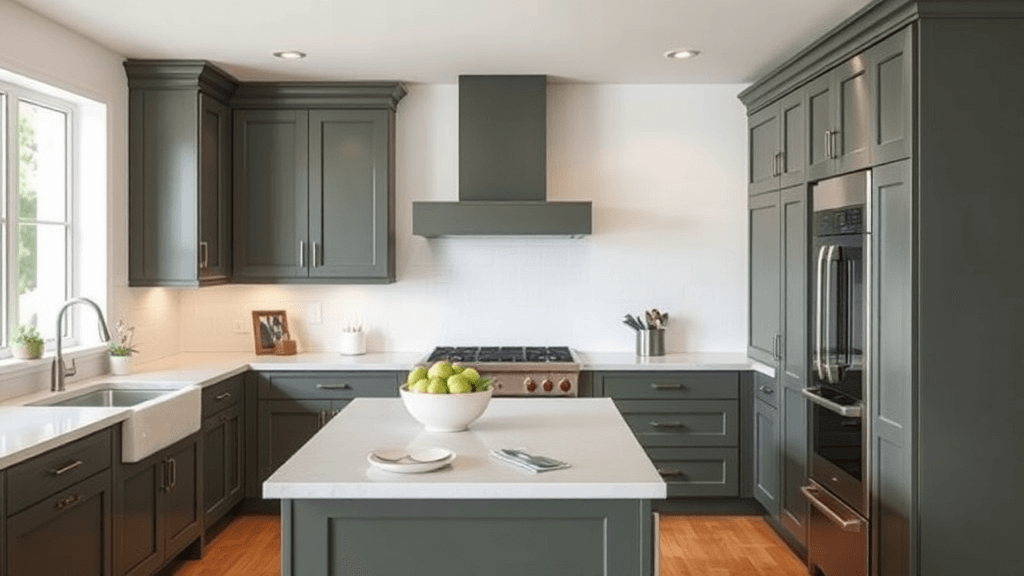
Pewter Green is a deep, mid-toned gray-green on most kitchen cabinets, making it a perfect choice for those seeking balance.
In standard kitchen lighting, this color brings depth to your space while remaining grounded and sophisticated.
Most kitchens with Pewter Green cabinets display a rich, steady tone that works well against various backgrounds.
The color stands strong but never fights for attention, creating a subtle focal point that anchors the kitchen design.
How Light Changes the Color
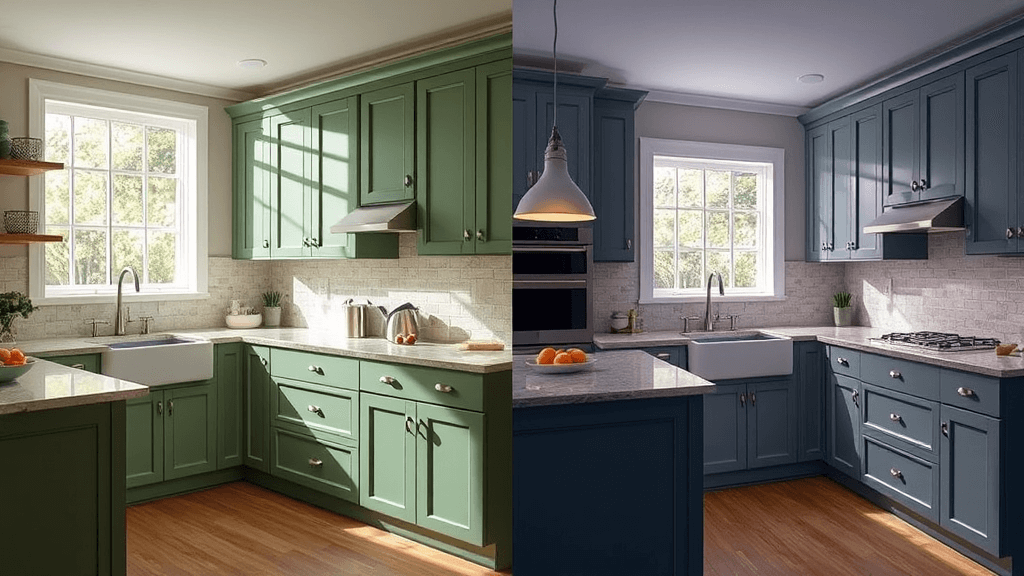
Natural morning light brings out the brighter, clearer green notes in Pewter Green cabinets. As sunlight fills the kitchen, the color becomes more energetic and shows its warmer side.
Early daylight truly highlights this shade’s fresh qualities.
The evening brings a dramatic shift to Pewter Green. Under artificial lighting, the cabinets take on cooler, bluer tones.
This transformation shows the color’s range, creating an almost new look as day turns to night. The gray undertones become more noticeable, adding depth to your kitchen space.
Perfect Pairings for Pewter Green
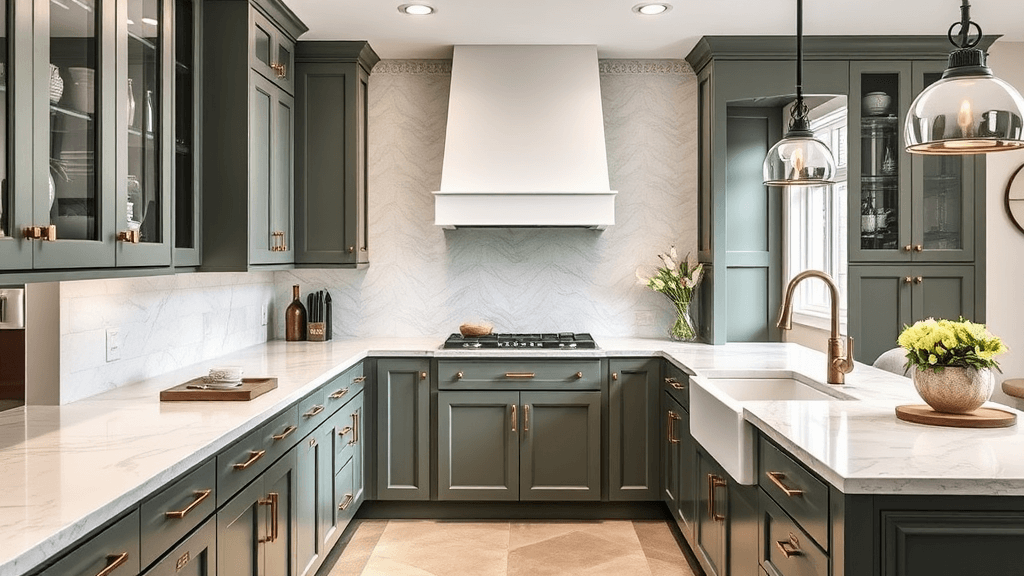
Hardware selection can change the entire feel of Pewter Green cabinets.
Gold pulls and knobs create warmth and striking contrast, while black hardware offers a clean, modern statement. Brushed nickel provides a subtle touch that ties everything together nicely.
Countertop choices determine the final look. White quartz creates a bright, clean contrast against the cabinets, while marble adds natural movement to the design.
The natural wood tones of butcher block counters bring warmth, and the light gray stone surfaces perfectly complement the cabinet’s undertones.
Wall colors set the stage for Pewter Green cabinets to shine. White walls maximize brightness and create a striking contrast.
Light gray walls seamlessly complement the cabinets, while cream and beige walls add warmth to the overall design.
How to Choose the Right Shade of Pewter Green
Understanding Your Options
Like Acacia Haze, lighter versions often benefit smaller kitchens, while larger spaces can embrace Pewter Green’s deeper tones.
The size and layout of your kitchen play a big role in how the color will feel in your space.
Light Exposure Matters
South-facing kitchens with lots of natural light handle Pewter Green beautifully. North-facing kitchens might need a lighter shade to keep the space bright.
When you use your kitchen most – morning light brings out different tones than evening lighting.
Testing Your Color
Take time to test your color choice properly. Paint large sample boards and view them at different times of day.
Move them around your kitchen to see how they look against your counters, floors, and walls.
Watch how the color changes from morning to night, including under artificial lights.
Complementary Elements for Pewter Green Cabinets
A. Best Countertop Options
- White Quartz or Marble: These materials create a light, clean contrast against Pewter Green cabinets, brightening up the space and adding a touch of luxury.
- Butcher Block: Adds warmth and texture, balancing the cool tones of the cabinets with a natural, inviting feel.
B. Hardware Choices
- Black or Pewter Hardware: Sleek and modern, these finishes complement the deeper tones of Pewter Green, adding sophistication without overpowering the design.
- Gold or Brass Hardware: These warmer tones create a pop of contrast, bringing out the richness in Pewter Green while adding elegance to the kitchen.
C. Wall and Backsplash Pairings
- Neutral Wall Colors: Whites, off-whites, and soft grays create a bright, complementary backdrop for Pewter Green, enhancing its natural beauty.
- Backsplash Ideas: To complement the cabinets further, consider white subway tiles or marble backsplashes. These options maintain a clean, timeless look that allows the Pewter Green to stand out.
Alternatives to Pewter Green for Cabinets
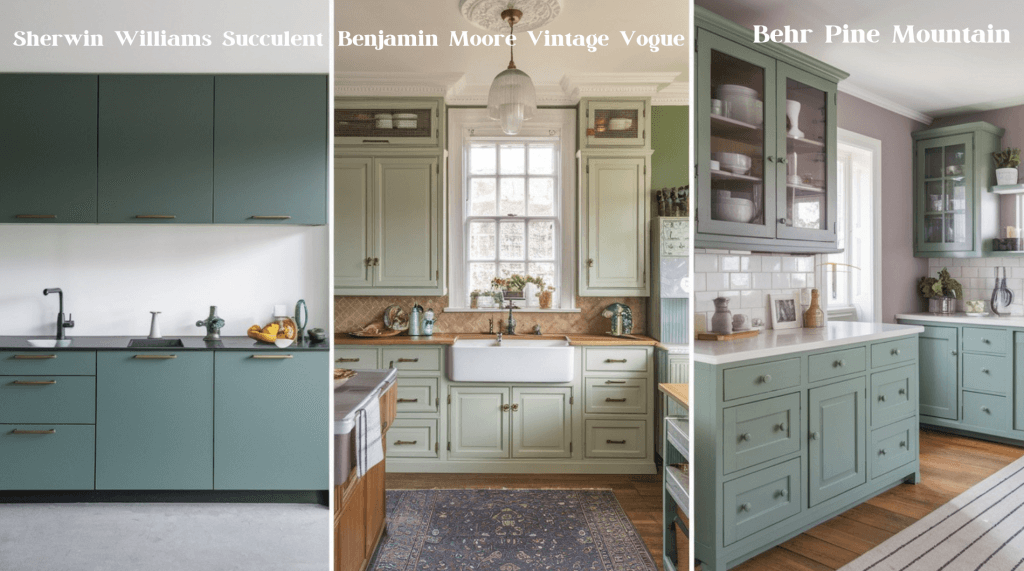
Similar Green Shades
- Sherwin Williams Succulent: A cooler green with more blue undertones, perfect for a modern, sleek look. It offers a fresh, vibrant alternative to Pewter Green, making it ideal for contemporary kitchens.
- Benjamin Moore Vintage Vogue: This warmer green adds a touch of earthiness to a traditional kitchen. It’s a great option if you’re looking for a more classic or vintage feel.
- Behr Pine Mountain: A grayer, cooler green that offers a similar aesthetic to Pewter Green but with a slightly more muted, softer tone.
When to Consider These Alternatives
- Design Preferences: Succulent may be the right choice if you’re aiming for a more modern or cooler vibe. For a warmer, more traditional look, Vintage Vogue is a great option.
- Lighting: In a kitchen with limited natural light, opting for a lighter or cooler green, like Behr Pine Mountain, can help keep the space feeling fresh.
- Texture and Accents: Consider your countertops and other elements. For example, Pine Mountain pairs well with natural textures, while Succulent works beautifully with sleek, minimalist designs.
Conclusion
Pewter Green cabinets offer more than just a color choice—they create a foundation for your kitchen’s personality.
This shade proves its worth by adapting to different lighting, pairing it with various hardware options, and maintaining its appeal over time.
Whether you’re drawn to its sophisticated gray-green blend or considering lighter alternatives like Succulent or Vintage Vogue, remember that cabinet colors shape your daily kitchen experience.
The key is to understand your space’s lighting, test samples thoroughly, and choose finishes that match your lifestyle.
In the end, picking the right cabinet color comes down to what makes you smile when you walk into your kitchen each morning.

